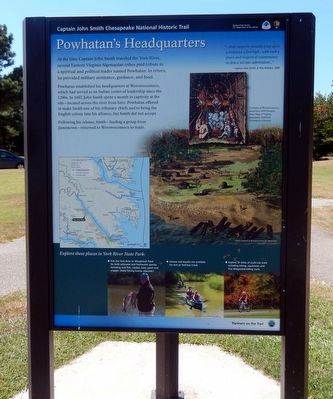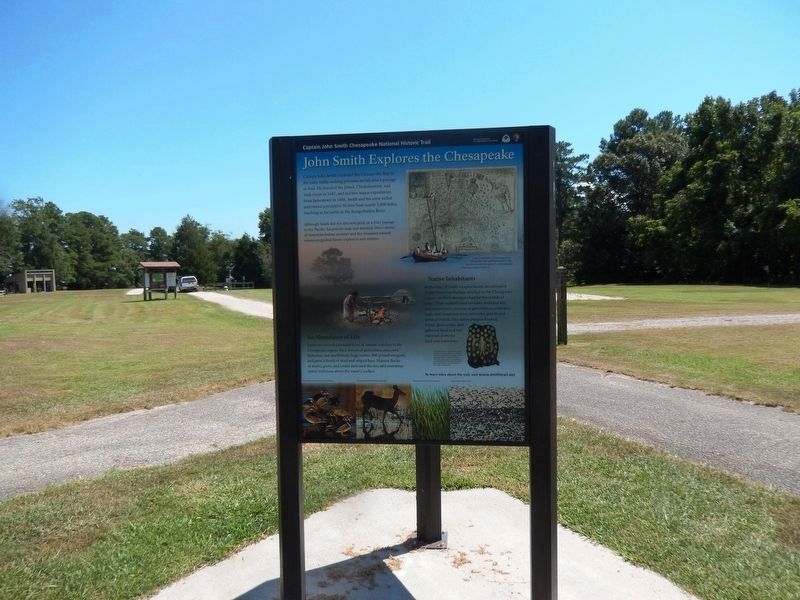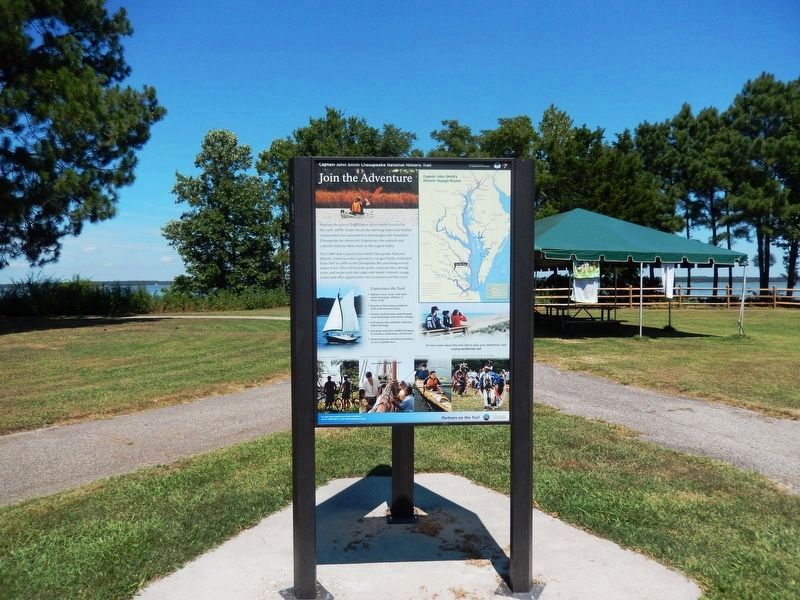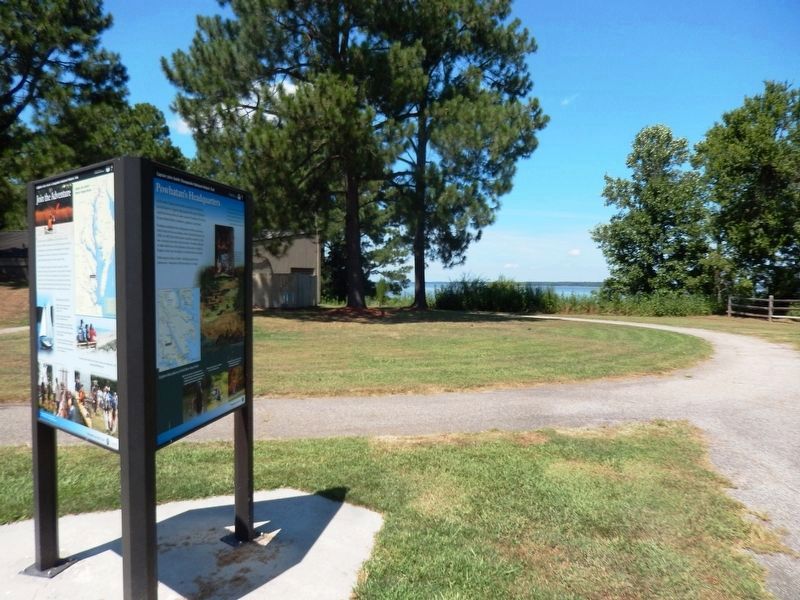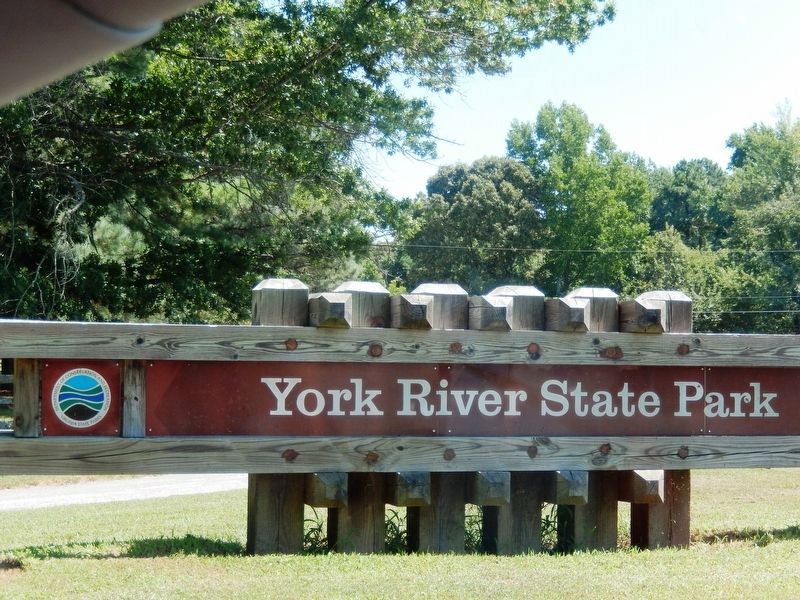Near Williamsburg in James City County, Virginia — The American South (Mid-Atlantic)
Powhatan’s Headquarters
Captain John Smith Chesapeake National Historic Trail
— National Park Service, U.S. Department of the Interior —
(panel 1)
Powhatan's Headquarters
At the time Captain John Smith traveled the York River, several Eastern Virginia Algonquian tribes paid tribute to a spiritual and political leader named Powhatan. In return, he provided military assistance, guidance, and food.
Powhatan established his headquarters at Werowocomoco, which had served as an Indian center of leadership since the 1200s. In 1607, John Smith spent a month in captivity at the site—located across the river from here. Powhatan offered to make Smith one of his tributary chiefs and to bring the English colony into his alliance, but Smith did not accept.
Following his release, Smith—leading a group from Jamestown—returned to Werowocomoco to trade.
…their emperor proudly lyiung upon a bedstead a foot high…with such a grave and majestical countenance as drave me into admiration…"
-Captain John Smith, A True Relation, 1608
(caption)
Powhatan at Werowocomoco, detail from 1630 Hondius-Blaeu Map of Virginia, Jamestown-Yorktown Foundation collection
(sidebar)
Explore these places in York River State Park:
• Fish the York River or Woodstock Pond for both for both saltwater and freshwater species including rock fish croaker, bass, perch and crappie (valid fishing license required)
• Canoes and kayaks are available for rent at Taskinas Creek.
• Canoes and kayaks are available for rent at Taskinas Creek.
• Explore 35 miles of multi-use trails including hiking, equestrian and five designated biking trails.
(panel 2)
John Smith Explores the Chesapeake
Captain John Smith explored the Chesapeake Bay in the early 1600s seeking precious metals and a passage to Asia. He traveled the James, Chickahominy, and York rivers in 1607, and led two major expeditions from Jamestown in 1608. Smith and his crew sailed and rowed a primitive 30-foot boat nearly 3,000 miles, reaching as far north as the Susquehanna River.
Although Smith did not discover gold, or a river to the Pacific, his precise map and detailed observations of American Indian societies and the abundant natural resources guided future explorers and settlers.
Native Inhabitants
At the time of Smith's explorations, an estimated 50,000 American Indians dwelled in the Chesapeake region—as their ancestors had for thousands of years. Their sophisticated societies included arts and architecture, systems of government, extensive trade and communication networks, and shared spiritual beliefs. The native people hunted, fished, grew crops, and gathered food and raw materials from the land and waterways.
An Abundance of Life
Smith discovered a treasure trove of natural wonders in the Chesapeake region: thick forests of giant pines, oaks, and hickories; vast marshlands, huge turtles, 800-pound sturgeon, and great schools of shad and striped bass. Massive flocks of ducks, geese, and swans darkened the sky; and enormous oyster reefs rose above the water's surface.
To learn more about the trail visit www.smithtrail.net
(captions)
Smith’s remarkably accurate map of the Chesapeake Bay (published in 1612), and his spirited written accounts of a lush landscape inspired European migration.
Decorative shells-such as those found on this ceremonial robe-were valuable in the American Indian’s trading network that extended for hundreds of miles. This robe (which may have belonged to paramount chief Powhatan) was crafted from four elk skins and adorned with more than 17,000 shells.
Wood ducks and other waterfowl flourished
The forests and lowlands teemed with deer
Cattails grew thick in pristine marshes
Flocks of geese filled the sky
(panel 3)
Join the Adventure
Explore the places Englishman John Smith traveled in the early 1600s. Learn about the thriving American Indian communities he encountered and imagine the bountiful Chesapeake he observed. Experience the natural and cultural richness that exists in the region today.
The 3,000-mile Captain John Smith Chesapeake National Historic Trail traces the exploratory voyages Smith conducted from 1607 to 1609 on the Chesapeake Bay and along several major rivers. The trail includes parks, museum sites, driving tours, and water trails that align with Smith's historic voyage routes and offer opportunities for recreation and discovery.
Experience the Trail
• Explore rivers, coves, and open water by kayak, sailboat, or motor craft.
• Bicycle or hike along woodland trails and shoreline paths.
• Follow winding back roads through rural landscapes and historic villages.
• Visit places that celebrate American Indian heritage.
• See birds and other wildlife foraging in marshes, waterways, and forests.
• Attend festivals and demonstrations, or join a guided tour.
To learn more about the trail and to plan your adventure, visit
www.smithtrail.net
(captions)
Captain John Smith’s Historic Voyage Routes
“Here are mountains, hils, plaines, valleys, rivers, and brookes all running most pleasantly into a faire Bay compassed but for the mouth with fruitful and delightsome land.”
– John Smith, 1612
Overlooking the Susquehanna River
Students
aboard Discovery at Jamestown Settlement
Kayakers explore the trail
Indian dance demonstration at Jefferson Patterson Park and Monument
Erected 2015 by National Park Service, U.S. Department of the Interior.
Topics and series. This historical marker is listed in these topic lists: Colonial Era • Exploration • Native Americans • Settlements & Settlers. In addition, it is included in the Captain John Smith Chesapeake National Historic Trail series list. A significant historical year for this entry is 1607.
Location. 37° 24.864′ N, 76° 42.786′ W. Marker is near Williamsburg, Virginia, in James City County. Marker can be reached from York River Park Road (County Route 696) 2.1 miles north of Riverview Road (County Route 606), on the right when traveling north. The marker is located in York River State Park to the right of the Visitor Center. Touch for map. Marker is at or near this postal address: 9801 York River Park Road, Williamsburg VA 23188, United States of America. Touch for directions.
Other nearby markers. At least 8 other markers are within 6 miles of this marker, measured as the crow flies. James City County / York County (approx. 3.8 miles away); Norge Depot (approx. 4½ miles away); Olive Branch Christian Church (approx. 4.8 miles away); Cappahosic (approx. 5 miles away); Gloucester Agricultural and Industrial School (approx. 5.1 miles away); Hickory Neck Church (approx. 5.2 miles away); White Hall Tavern (approx. 5.3 miles away); Chickahominy Church (approx. 5½ miles away). Touch for a list and map of all markers in Williamsburg.
Also see . . .
1. Captain John Smith Chesapeake National Historic Trail. National Park Service (Submitted on August 29, 2016.)
2. York River State Park. Virginia Department of Conservation and Recreation (Submitted on August 29, 2016.)
Credits. This page was last revised on June 12, 2020. It was originally submitted on August 29, 2016, by Don Morfe of Baltimore, Maryland. This page has been viewed 476 times since then and 29 times this year. Photos: 1, 2, 3, 4, 5. submitted on August 29, 2016, by Don Morfe of Baltimore, Maryland. • Bernard Fisher was the editor who published this page.
